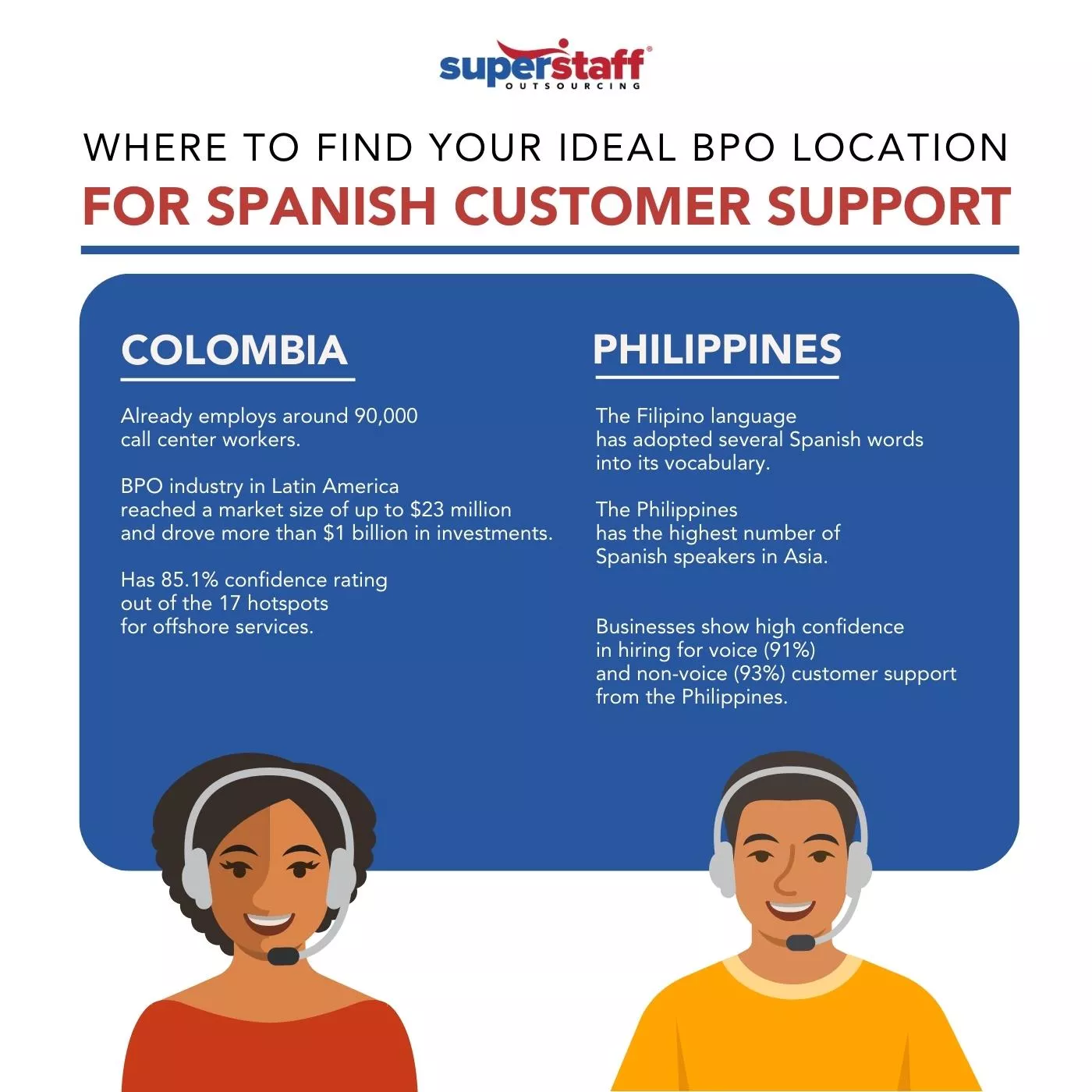
As the economy gets progressively cutthroat and made more rigid by digitalization, the natural progression for many businesses is to diversify target markets. Building a team of Spanish customer service representatives can be the ideal solution if you want to reach key global markets such as Europe and Latin America.
But why the Spanish-speaking agents specifically?
- Hispanic Americans comprise 19% of the entire U.S. population — more than 62 million people and are growing.
- The U.S. Hispanic consumers have $2.5 trillion in buying power as of 2020.
- Spanish is the most common second language in the world.
- 548.3 million people speak Spanish globally as of 2022.
- Spanish has the fourth-largest number of speakers globally, next to Hindi and Mandarin.
- Hispanic buyers account for $1.5 trillion of the market share in the U.S. alone.
- By estimates, more than 111.22 million people of Hispanic descent can be in the U.S. by 2060.
- 39% of consumers want a knowledgeable Spanish-speaking customer service representative.
- They also want their issues resolved after the initial contact and prefer that they aren’t transferred to different agents.
Indeed, a customer service representative (Spanish-speaking) offers you a gateway to global opportunities that many of your competitors haven’t recognized yet.

They can expand your reach in Latin America and Europe.
Spanish is the official language of at least 20 countries, primarily in Latin America, including Bolivia, Peru, Uruguay, Chile, and Argentina. Mexico and Colombia have the most native Spanish speakers worldwide, with 124.85 million and 50.64 million speakers, respectively. Quickly, you can scale your business to these Latin American markets.
Additionally, Spanish is listed as one of the official languages in the European Union, thus extending your reach to the European markets.
Spain is the heart of European Spanish speakers, with 43.64 million native speakers. Also, Spain constitutes at least $21.9 billion in the U.S. export market.
Moreover, Spanish is widely spoken in Andorra, Gibraltar, and Switzerland. There are also small clusters of Spanish speakers in other E.U. countries, like France, Germany, Italy, and the U.K.
Thus, Spanish customer representatives significantly mediate the transactions between Spanish, European, and American clients. If you want your business to prosper in foreign and local markets, you should outsource a team of customer service professionals who speak Spanish fluently.
They can give your Spanish customers a sense of freedom to use their mother tongue.
The misconception is that all people in the U.S. prefer speaking English. False. Twenty-five million people in America won’t use English, let alone in European countries.
Thus, employing only one common language in your customer service may lead to miscommunication and confusion with Spanish-speaking clients. Take a look at these numbers showing the effects of miscommunication between businesses and customers:
- 12% lose customers to competitors.
- 42% suffer from fatigue and burnout.
- 68% overlooked messages or potential business deals.
Worse, there’s also a possibility that you may unintentionally marginalize your current or prospective customers because they aren’t native English speakers.
In short, you shouldn’t expect your Spanish-speaking customers to learn a new language just to be able to interact with your brand representatives. They will find this difficult.
That’s why customers need to be allowed to speak in their native language and be understood. As a company, you become more of an active listener when you enable them to communicate their issues and concerns in their mother tongue.
You need to meet them where they are and hire a customer support team to converse with them in Spanish. This way, you encourage effective communication with your customers and avoid losing their business due to miscommunication.
They have a deeper understanding of the cultural nuances of the Spanish language.
As mentioned, Spanish is spoken in many different parts of the world. But that doesn’t mean all these countries speak Spanish the same way.
Similar to British and American English, there are also differences between Spanish spoken in Spain and Spanish in Latin America regarding cultural nuances, pronunciation, grammatical differences, or slang.
Even the word “Spanish” is called differently by the two regions. Latin Americans refer to the language as español (Spanish), while the Spaniards call them Castellano (Castilian) because it was claimed to have originated from the Castile province in central Spain.
Here are other notable idiosyncrasies about the Spanish dialects:
- Tenses: Spanish uses the present perfect tense, while Latin Americans prefer speaking in the simple past tense.
- Personal pronouns: Spanish speakers use “vosotros” to refer to the plural “you” informally. In Latin America, the locals use “ustedes” for the formal and informal plural “you.”
- Vocabulary: For instance, the Spaniards refer to a pen as “bolígrafo” or “bold.” But in Latin America, “pluma” or “lapicera” are used instead.
Even among the different Latin American countries, there are wide varieties of local vocabularies and colloquial expressions only used in a specific region. For example, Chile’s cultural references may differ from those in Mexico.
Furthermore, there are also generational differences among Hispanics in the U.S. Each has its distinct behavior as follows:
- Traditionalists: They pertain to older immigrants or younger ones who aren’t proficient English speakers. They prefer Spanish-speaking TV and radio ads and Spanish online platforms.
- Millennials and Gen Z: Second-generation Hispanics born in the U.S. Since they grew up in the U.S., they may acquire American customs and interests while embracing their own cultural heritage. Because of this, Spanglish would be the perfect communication medium for them. Forbes reports that 62% of Millennial Hispanics are more inclined to use Spanglish as it reflects their identity of balancing their American and Hispanic cultures.
Take note that 68% of clients expect lines of communication to be personalized. Recognizing the subtle distinction in your customer’s language helps you create authentic and long-lasting relationships with your customers. You’re making them feel at home with every interaction.
More than 90% of customers are more likely to spend money when their experience is more personalized and smooth-running.
In short, there are cultural nuances in every Spanish-speaking region. The right Spanish customer support team can help you navigate these different Spanish dialects and localize your customer service for the specific countries you are targeting.
They promote customer satisfaction and loyalty among Spanish consumers.
The unemployment rate in Spain has been at its lowest record since the last decade. Therefore, people’s increased purchasing power made them hypersensitive to prices and value attractive deals.
One result is that Spanish consumers have become quite difficult to please. Hence, earning their loyalty takes effort. To impress your Spanish buyers and win their business, you should offer customer service in their language and understand their behavior as consumers.
Take a look at these numbers:
- 75% of buyers search for a bargain before purchasing.
- 25% defect from their regular vendors if other places offer lower rates.
- 70% of clients are willing to wait for seasonal sales to make massive purchases.
Customer loyalty and retention result from a business consistently reaching and surpassing customer expectations. And part of these expectations is for consumers to speak their language.
Take a look at these numbers:
- 76% of consumers prefer buying items with information in their native language.
- 29% of businesses have lost clients because they neglected multilingual support.
Those numbers highlight the importance of speaking your customer’s language and creating content and product details in multiple languages. If companies make this feature available for their customer care, they will retain more recurring customers:
- 70% of buyers stay with companies that offer customer support in their native tongue.
- 62% of customers can tolerate issues with a product if they can speak with customer hotlines in their native language.
- 58% are willing to wait longer for replies from customer support if it interacts in their mother tongue.
- By speaking in your customer’s native tongue, the customer satisfaction (CSAT) rate can increase to 72%.
They help you gain a significant competitive edge in the global business landscape.
We’ve talked extensively about how a Spanish customer service representative benefits businesses, but did you know that only a few companies offer customer service in languages other than English?
In that aspect, you’ll stand out and gain admiration from the Spanish-speaking community, earning your business free marketing in the form of good word of mouth.
Why aim for positive word-of-mouth (WOM)?
- 74% of consumers state that WOM affects their purchasing decision.
- Positive WOM increases the possibility of buyers purchasing a product from a business by four times.
- WOM generates $6 trillion of yearly consumer spending.
Where to Find Your Ideal BPO Location for Spanish Customer Support

Establish nearshore call center operations in Colombia.
With a sizable Spanish-speaking community population and a thriving BPO industry, Colombia has become one of the go-to offshoring destinations for U.S.-based companies.
Currently, the Latin American country hires over 600,000 individuals. Bogotá alone, Colombia’s capital city of call centers, already employs around 90,000 workers. But this number is projected to surge as the world realizes its competence in the customer service market.
Being the fourth-largest business process outsourcing (BPO) industry in Latin America, it manages to reach a market size of up to $23 million and drive more than $1 billion in investments worldwide. Besides, the country accommodates a massive workforce of 26.4 million professionals, the third largest in the LatAm region.
In a recent survey, Colombia also gathers the most confidence out of the 17 hotspots for offshore services, accruing a confidence index of 85.1%. Many companies love doing business with this country because of its skillful labor market, stellar infrastructural lines, and reputable BPO ecosystem.
Furthermore, the cost of outsourcing professionals from Colombia is also highly efficient. Check out the rough pay estimates:
- The average monthly salary in Colombia is about $1,029 as of May 2023.
- A customer service agent receives about $1,870 in monthly payments.
Offshore Spanish-speaking customer support to the Philippines.
Filipinos are known worldwide for their high English proficiency. Additionally, they also have many Spanish speakers.
Due to the 333 years of Spanish colonization, the Standard Filipino language has adopted several Spanish loan words into its vocabulary, with around 4,000 words originating from the language. It even stayed as a co-official language with English until 1987, before it was classified as an optional language instead.
About 0.5% of the 100 million Filipinos speak Spanish, the highest number of Spanish speakers in Asia. On top of that, a region in the Southern Philippines still preserves one of the last relics of Spanish colonial rule — the Chavacano, a Spanish Creole dialect. At least 700,000 locals speak the dialect in the country.
Even businesses show high confidence in hiring for voice (91%) and non-voice (93%) customer support because of its viable labor market. This shows Filipinos have grown accustomed to the Spanish culture, making them ideal customer service representatives for Hispanic markets.
Nearshore and Offshore Spanish Customer Service Representatives
Your goal is always to make your customers feel important. And many Spanish-speaking customers feel valued when the customer service representative they speak to is proficient in their mother tongue. The ability to communicate in both written and spoken Spanish is fundamental to understanding and tackling customer concerns seamlessly.
So, if you’re eyeing entrepreneurial growth, nearshoring, and offshoring services should be your priority — especially when you want to appeal to the Spanish-speaking population.
SuperStaff’s headquarters in Colombia and the Philippines are known for their great values, effective results, and customer service excellence. More significant returns await when you work with a reliable provider offering an outstanding Spanish customer service representative team.
Call us today, and let’s see how we can work together to build you a Spanish customer service team.






